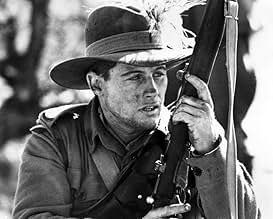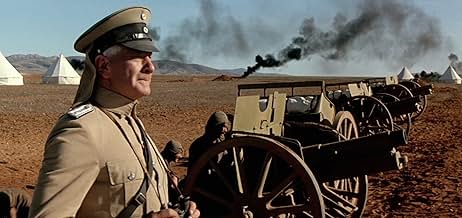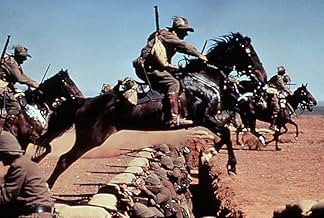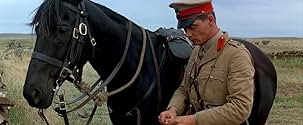IMDb-BEWERTUNG
6,8/10
2171
IHRE BEWERTUNG
Als die britischen Streitkräfte 1917 vor den türkischen und deutschen Linien in Palästina festsitzen, verlassen sie sich auf das australische leichte Pferderegiment, um aus der Sackgasse her... Alles lesenAls die britischen Streitkräfte 1917 vor den türkischen und deutschen Linien in Palästina festsitzen, verlassen sie sich auf das australische leichte Pferderegiment, um aus der Sackgasse herauszukommen.Als die britischen Streitkräfte 1917 vor den türkischen und deutschen Linien in Palästina festsitzen, verlassen sie sich auf das australische leichte Pferderegiment, um aus der Sackgasse herauszukommen.
- Auszeichnungen
- 2 Gewinne & 1 Nominierung insgesamt
Jack Heywood
- Dave's Dad
- (as John Heywood)
Empfohlene Bewertungen
This colossal 1987 production - believe it or not - from RKO PICTURES is an Australian film closely resembling LAWRENCE OF ARABIA in its intent and rightly compared to ZULU. With a huge cast of Oz actors and directed by PHAR LAP (look it up) warhorse Simon Wincer it is basically about the last massive charge in the Middle East desert during World War One....an event still on the yearly Australian military forces roster of "Anzac" celebrations. Many other comments on this site will give you details of the history of the event and rightly applaud this lavish spectacular film. RKO Pictures had reformed with some co financing in the 80s and this is one of their few productions. BEST LITTLE WHOREHOUSE and THE BORDER are two others that spring to mind produced with Universal Pictures. With a $7 million budget and all of it on screen THE LIGHTHORSE became the last of the truly international films from Australia in the 80s. Others of this time are GALLIPOLI and CAREFUL HE MIGHT HEAR YOU and THE MAN FROM SNOWY RIVER and WE OF THE NEVER NEVER...each are films made with a lavish widescreen cinema release in mind and each huge Oz successes. THE LIGHTHORSEMEN is well worth the 140 minutes or so of carefully paced storytelling, all laced with Aussie humor and superb design and photography. The charge in the last two reels is truly breathtaking and on a cinema screen was particularly overwhelming, rivaling the battle charge in LAWRENCE OF ARABIA for sheer thrilling visuals. No CGI in this film... it is all real and scary and played and filmed for keeps. One thrill for cinema owners of the day was to have the film commence with the original cinema scope RKO logo...beeping away from the tower on top of the world. Wonderful!
A First World War Australian cavalry -- sorry, mounted infantry -- film set in the Holy Land, that's not something one tends to see every day. So, for me, the fact that, yes, the characters and situations can be a little clichéd at times is far outweighed by the novelty of the whole scenario. Quibbles are easy to put to one side.
The cavalry distinction is important. Cavalry would be armed with carbines and sabres. Mounted infantry have rifles and dismount in order to fight. This subtlety plays a part in the outcome.
A series of small skirmishes heightens tension within the film until the exciting finale, when there is a fantastic, large scale, cav ... mounted infantry charge which got my pulse racing. You'll recall something similar in David Lean's "Lawrence of Arabia". This set piece is bigger. Johnny Turk was the villain that time too.
This being an Australian Imperial Force meets the British Army sort of film, there is bound to be a little Pommy-bashing going 'round. When I lived briefly in Australia a decade ago, I found Pommy-bashing to be the single unattractive facet to the Australian national character. (The Kiwis don't do it. We like Poms here too. Pity the Dominions can't agree on that one.) So while some of the Poms in this film might be a few sheep short of a paddock, still there *is* balance, with one Pom who is much cleverer than the average. Bashing even works its way into the plot, a nice touch that.
The film does not use an excessive amount of Strine lingo -- billy, tucker -- so very little acclimatization is necessary for the uninitiated.
I can't vouch for the overall authenticity of this film. But I did notice that campaign map in the Turkish commander's office. It's labelled in Arabic only. Egypt is identified as "Misr". Geez, that is the correct Arabic name. And the Ottomans were still using the Arabic alphabet at the time. (It's Atatürk after the war who switched Turkish over to the Roman alphabet.) The thing's fair dinkum, mate. If they cared enough to get details like that right, then I'm sure that says a lot about the effort put into the film as a whole.
There is an earlier Australian film about the Light Horse I'd like to see, "Forty Thousand Horsemen" from 1940 or '41 (sources differ). Finding a copy of that film in this hemisphere though would be extraordinary, a bit like finding a North American who likes Vegemite.
The cavalry distinction is important. Cavalry would be armed with carbines and sabres. Mounted infantry have rifles and dismount in order to fight. This subtlety plays a part in the outcome.
A series of small skirmishes heightens tension within the film until the exciting finale, when there is a fantastic, large scale, cav ... mounted infantry charge which got my pulse racing. You'll recall something similar in David Lean's "Lawrence of Arabia". This set piece is bigger. Johnny Turk was the villain that time too.
This being an Australian Imperial Force meets the British Army sort of film, there is bound to be a little Pommy-bashing going 'round. When I lived briefly in Australia a decade ago, I found Pommy-bashing to be the single unattractive facet to the Australian national character. (The Kiwis don't do it. We like Poms here too. Pity the Dominions can't agree on that one.) So while some of the Poms in this film might be a few sheep short of a paddock, still there *is* balance, with one Pom who is much cleverer than the average. Bashing even works its way into the plot, a nice touch that.
The film does not use an excessive amount of Strine lingo -- billy, tucker -- so very little acclimatization is necessary for the uninitiated.
I can't vouch for the overall authenticity of this film. But I did notice that campaign map in the Turkish commander's office. It's labelled in Arabic only. Egypt is identified as "Misr". Geez, that is the correct Arabic name. And the Ottomans were still using the Arabic alphabet at the time. (It's Atatürk after the war who switched Turkish over to the Roman alphabet.) The thing's fair dinkum, mate. If they cared enough to get details like that right, then I'm sure that says a lot about the effort put into the film as a whole.
There is an earlier Australian film about the Light Horse I'd like to see, "Forty Thousand Horsemen" from 1940 or '41 (sources differ). Finding a copy of that film in this hemisphere though would be extraordinary, a bit like finding a North American who likes Vegemite.
I saw only the last half of this one, appropriately enough on Anzac Day, tuning in just as the delicious Nurse Siggy Thornton is writing a love letter that intelligence Major Anthony Andrews is going to mislead Johnny Turk with. So I missed the alleged tedium of the first hour. The film is no doubt best viewed on a big screen, but what I did see in the last hour was the Australian Light Horse attack on Beersheba, brilliantly staged and filmed, with hundreds of horses and extras and tonnes of dramatic tension.
The actual battle was an Aussie military success, due in large part to their opponents, especially the Germans, underestimating them. It was a change from Gallipoli, where some of the horsemen had fought a couple of years earlier. It was terribly thoughtful of the Australian commanders to order the attack an hour before sunset when the light is best, and Dean Semler the cinemaphotographer takes full advantage of it. The close camera shots in the battle really give you the feeling you're right in it - there is nothing particularly original about "Saving Private Ryan" made 10 years later.
Yes, it's a cliché-ridden and chauvinistic script. The real villains are the Germans, all from Central Casting's Nazi division, despite this being a movie about the FIRST World War, but the British officers are also portrayed as pretty perfidious - the guys who made snobbery an art form to cover their incompetence. The Turks, though, are shown as brave and worthy opponents, if a little under the Germans' thumb. No doubt John Ford would have done it differently (I'm not sure he would have handled the horses any better) but this is the Australian point of view. A Turkish version would be interesting.
Anyway, worth it for the final battle.
The actual battle was an Aussie military success, due in large part to their opponents, especially the Germans, underestimating them. It was a change from Gallipoli, where some of the horsemen had fought a couple of years earlier. It was terribly thoughtful of the Australian commanders to order the attack an hour before sunset when the light is best, and Dean Semler the cinemaphotographer takes full advantage of it. The close camera shots in the battle really give you the feeling you're right in it - there is nothing particularly original about "Saving Private Ryan" made 10 years later.
Yes, it's a cliché-ridden and chauvinistic script. The real villains are the Germans, all from Central Casting's Nazi division, despite this being a movie about the FIRST World War, but the British officers are also portrayed as pretty perfidious - the guys who made snobbery an art form to cover their incompetence. The Turks, though, are shown as brave and worthy opponents, if a little under the Germans' thumb. No doubt John Ford would have done it differently (I'm not sure he would have handled the horses any better) but this is the Australian point of view. A Turkish version would be interesting.
Anyway, worth it for the final battle.
This is an excellent film with surely the finest cavalry charge ever filmed. In this movie the horse is King and the care taken to illustrate the vital interaction between these magnificent animals and their riders is great to behold. The acting and direction are good without the need for big names. It has had a number of releases, the best being a 2.35 wide screen laser disc version in the USA. Australia has released a DVD version but it is dreadfully truncated being cut to 1.78 from the vastly more meaningful aspect ratio of the laser disc. On the big screen this film makes a fantastic impact and every effort should be made to see the original wide screen version in this way. Highly recommended.
This is a story about some episode British-Turk campaign in Palestine in 1917. Very important role in this campaign was played by Australian forces. The key to conquer the Holy Land is city of Gaza. British general wants however to throw his forces to bypass the city and capture another one - Beersheba. To take them both it is necessary to keep his plan secret.
As a person who is interested in all WWI history I was waiting for this movie. I find it very good. All equipment seems to be very accurate, however, I've never heard about use of tanks in this front. There is a nice scene of air attack by German biplane, cars from that times, uniforms, and so on -- it all seems to be historical correct. The final charge is worth waiting for. I think that anyone who is interested in this campaign would be satisfied.
Because of Australian point of view the role of British army seems to be a little underrated. I especially mean British commander -- general Allenby. I think it would be good to say at the very end that after capturing Beersheba, Gaza fell as well a week later, and the road to Jerusalem was opened. This was what was lacking for me.
As a person who is interested in all WWI history I was waiting for this movie. I find it very good. All equipment seems to be very accurate, however, I've never heard about use of tanks in this front. There is a nice scene of air attack by German biplane, cars from that times, uniforms, and so on -- it all seems to be historical correct. The final charge is worth waiting for. I think that anyone who is interested in this campaign would be satisfied.
Because of Australian point of view the role of British army seems to be a little underrated. I especially mean British commander -- general Allenby. I think it would be good to say at the very end that after capturing Beersheba, Gaza fell as well a week later, and the road to Jerusalem was opened. This was what was lacking for me.
Wusstest du schon
- WissenswertesWebsite Cinephilia reports of the Jon Blake accident and legal case: "Jon Blake was critically injured whilst driving home on December 1, 1986, after the final day's filming of The Lighthorsemen - Blutiger Sturm (1987). He sustained severe brain injuries and in December, 1995, the New South Wales Supreme Court ruled that Blake should be compensated for the loss of potential earnings as a star in the United States. After taking evidence from actors, directors, and film critics who indicated his career could have been as big as Mel Gibson's, the court awarded him $32 million in damages. This was later reduced to $7 million after the defence appealed."
- PatzerAt the rest camp just after the 2 soldiers pass the British Major and addresses the Colonel about the men wearing shorts at the end the Colonel calls the Major 'Sir', this wouldn't happen as a Colonel is a higher rank to Major.
- Alternative VersionenUK versions are cut by 6 secs to remove cruel horsefalls.
- VerbindungenEdited into Die Abenteuer des jungen Indiana Jones: Palestine, October 1917 (1993)
- SoundtracksAUSTRALIA WILL BE THERE
Music and lyrics by W.W. 'Skipper' Francis
By Arrangement with Allans Music (Australia) Pty. Limited
Top-Auswahl
Melde dich zum Bewerten an und greife auf die Watchlist für personalisierte Empfehlungen zu.
- How long is The Lighthorsemen?Powered by Alexa
Details
- Erscheinungsdatum
- Herkunftsland
- Offizielle Standorte
- Sprache
- Auch bekannt als
- The Lighthorsemen
- Drehorte
- St. Kilda, Melbourne, Victoria, Australien(beach, Mediterranean Sea)
- Produktionsfirmen
- Weitere beteiligte Unternehmen bei IMDbPro anzeigen
Box Office
- Budget
- 10.500.000 AU$ (geschätzt)
- Bruttoertrag in den USA und Kanada
- 33.779 $
- Eröffnungswochenende in den USA und in Kanada
- 23.645 $
- 10. Apr. 1988
- Weltweiter Bruttoertrag
- 34.514 $
- Laufzeit
- 2 Std. 11 Min.(131 min)
- Sound-Mix
- Seitenverhältnis
- 2.35 : 1
Zu dieser Seite beitragen
Bearbeitung vorschlagen oder fehlenden Inhalt hinzufügen




























